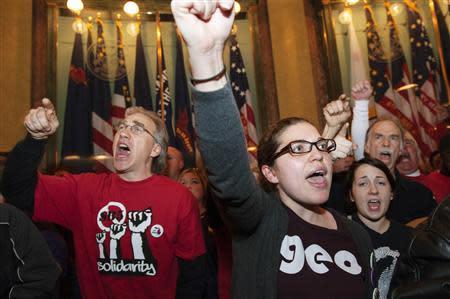Amid slight data, Michigan's right-to-work law fight rages on
By Nick Carey LANSING, Michigan (Reuters) - When Michigan became the 24th right-to-work state in December 2012, conservatives hailed it as a sign the Rust Belt state was "open for business," union workers decried the law as "union busting" and labor leaders vowed to use it to quash Republican Governor Rick Snyder's reelection bid in 2014. A year later, the impact of the law remains up for debate. Conservatives say it has already made Michigan more attractive to businesses, but it could take years before the economic benefits can be measured. Unions and Democratic opponents are pronouncing it a failure because unemployment has gone up. And in the gubernatorial race, it does not seem to be a central issue - at least not yet. Michigan's right-to-work law, which bans making union membership a condition of employment, is similar to those already in effect in 23 other states. Except for Indiana, which also passed a right-to-work law last year, laws in the other states have been in effect for years. Michigan stands apart because it is home to the United Auto Workers, the center of the U.S. auto industry, and a swing state in national elections, where worker rights can become polarizing issues. "Right-to-work has done none of the things its backers promised," said Bill Black, Michigan state legal and political director for the Teamsters union. "It has not brought better jobs and it has not helped the people of Michigan." But people outside the state are taking a different view. Tracy Bosman, a Chicago-based site selection consultant with Biggins Lacy Shapiro & Co, says Michigan's law has generated interest in the state. Up to 50 percent of manufacturers automatically screen out any non-right-to-work state, Bosman said, so Michigan was out of the picture for many companies looking to add production capacity. "While it does not guarantee success for Michigan, it does at least mean the state will get a second look from firms that automatically excluded it in the past," she said. Union leaders say the Michigan law has not hit membership numbers since it took effect in March. Unions have sought to persuade the rank-and-file that membership has value, with targeted marketing that included meeting with members statewide. "The workers here understand very clearly that right to work means the right to work for less," said the Teamsters' Black. He explained that fewer than 100 of the 50,000 workers it represents here have opted out. Department of Labor figures showing union membership in Michigan for 2013 will not be available until January, and the state itself does not collect such data. Federal data show Michigan's union membership is well above the national average of 11.3 percent of the workforce. The 2012 data showed union members made up 16.6 percent of the workforce - down from 17.5 percent in 2011, and a significant drop from 21.9 percent in 2003. Republicans argue the apparently limited effect of the law on union membership supports their argument that it is about "worker choice." And they claim unions have tried to limit choice with tactics designed to make it difficult for workers to opt out of membership. Doug Pratt, director of member benefits at the Michigan Education Association, disagreed, saying unions have used no underhanded methods to prevent members from leaving. Through "relentless hard work," the MEA has lost only 1,500 of the 110,000 members, he said. Chandra Madafferi, 39, has been a teacher for 16 years and identifies herself as politically conservative. She said she has stayed with the MEA because she feels the right-to-work law was part of an attack on public education and the middle class. "Being part of a union is the only way we can collectively fight against these laws that are hurting us," she said. Union representatives like Steve Kreisberg, national collective bargaining director of the American Federation of State, County & Municipal Employees, the largest U.S. public sector union, still worry about the law's long-term impact. Workers continue to get union representation even if they stop paying dues, so unions have to persuade people to keep contributing to their cause. "Frankly, we're in uncharted territory," Kreisberg said. STIRRINGS, BUT NO PROOF Any immediate effect on Michigan's unemployment rate is difficult to gauge. When the state passed its law last December, Governor Snyder said it would help attract businesses "so our families can enjoy more and better jobs." But Michigan's unemployment rate actually ticked up a fraction, to 9 percent in October from 8.9 percent last December. The national rate fell 7 percent during that time, from 7.8 percent when the law was passed. The Michigan Economic Development Corporation, a state-funded group, said new business investment has jumped during the same time period, up 33 percent in 12 months since the law passed, to around $1.6 billion. The announced investments would create 9,400 jobs, up from around 6,700 in the year before passage. Many of the investments in the past year were in the automotive sector and involved expanding existing manufacturing capacity. Warnings that wages would collapse have not panned out so far. Manufacturing wages were down about 2 percent in October compared with December 2012, but overall private sector wages rose about 2 percent. Governor Snyder said he has seen a growing interest in Michigan from site selection consultants. Passing the law "has created an environment where we're very competitive," he said. Michigan Economic Development Corporation chief executive Michael Finney said the state has also benefited from a reduction in the corporate income tax, reduced regulation, and improved fiscal discipline by state government. Even so, supporters of the law acknowledge there is little data to make a case that it is generating economic activity. "There is no way to empirically measure the economic impact of right-to-work because the data is not available," said Michael LaFaive, a director of fiscal policy at the Mackinac Center, a conservative think tank. "It will take a good 10 years of data to do that." Gretchen Whitmer, leader of the Democratic state Senate minority, said supporters are grasping at straws. "What are they going to say after 10 years have passed?" she asked. "That we need another 10, another 20?" POLITICS HEATING UP The law's effect on Michigan's politics is difficult to measure as well. Governor Snyder will be going up against relatively unknown former Democratic congressman Mark Schauer, yet a November poll from non-partisan Inside Michigan Politics had them statistically tied. Inside Michigan Politics publisher Susan Demas said a tax on pensions has been a bigger problem for Snyder than the right-to-work law. The tax has weakened Snyder's standing more among retirees, who are usually seen as part of the Republican base, she said. Cuts to education and a corporate income tax reduction may also overshadow right-to-work during the campaign, Demas said. Union representatives acknowledge that the law, so far, is not emerging as a wedge issue. "There's probably only a subset of people angry over right to work," said the MEA's Pratt. "But what has people really angry is this administration's favoring special interests and not what's best for the people of this state. That's what will determine the outcome of next year's election." (Reporting By Nick Carey; editing by David Greising and Gunna Dickson)



